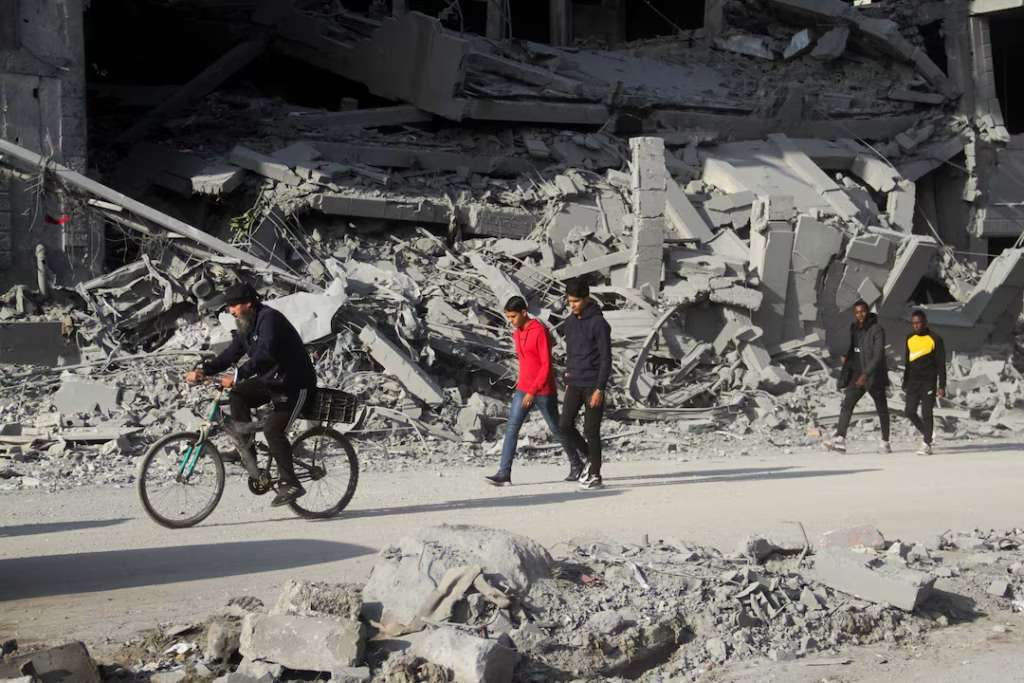Israel intensified its airstrikes on Gaza mere hours after the announcement of a ceasefire agreement and a hostage release deal. Residents and officials in the Palestinian enclave reported the attacks, while mediators raced to prevent further escalation before the truce’s scheduled start on Sunday.
The intricate ceasefire agreement between Israel and Hamas, the governing authority in Gaza, came after months of mediation by Qatar, Egypt, and the United States. The deal aims to end 15 months of devastating bloodshed that have left the coastal strip in ruins and heightened tensions across the Middle East.
The ceasefire agreement outlines a six-week truce and a phased withdrawal of Israeli forces from Gaza. This withdrawal is tied to an exchange—Hamas will release hostages in return for Palestinian prisoners held in Israeli custody.
At a press conference in Doha, Qatari Prime Minister Sheikh Mohammed bin Abdulrahman Al Thani confirmed that the ceasefire would begin on Sunday. He emphasized that negotiators were coordinating with both Israel and Hamas to ensure a smooth implementation of the agreement.
US President Joe Biden, flanked by Vice President Kamala Harris and Secretary of State Antony Blinken, hailed the agreement as a turning point. “This ceasefire agreement will end hostilities in Gaza, bring much-needed humanitarian aid to Palestinian civilians, and reunite hostages with their families after over 15 months in captivity,” Biden said during remarks at the White House.
Outgoing US President Donald Trump also claimed credit for the breakthrough. His administration played a critical role, with his envoy Steve Witkoff working alongside Biden’s team in Qatar to finalize the deal.
Ongoing Strikes
Despite the announcement, Israeli forces intensified attacks in Gaza. Civil emergency services and residents reported heavy bombardments, particularly in Gaza City, late Wednesday. Medical sources confirmed 32 fatalities during these strikes. Further attacks destroyed homes in Rafah, Nuseirat, and northern Gaza.
While Israel’s military did not comment, there were no reports of Hamas launching attacks on Israel after the ceasefire agreement was announced. A Palestinian official close to the negotiations revealed that mediators were urging both sides to halt hostilities ahead of the truce’s implementation.
Relief and Jubilation
In Gaza, news of the ceasefire agreement sparked celebrations despite the ongoing violence. Crowds flooded the streets of Khan Younis, waving Palestinian flags and cheering. Many residents expressed cautious optimism, fearing Israel might escalate attacks before the truce begins.
“I am happy. Yes, I’m crying, but these are tears of joy,” said Ghada, a displaced mother of five.
Families of Israeli hostages in Tel Aviv also celebrated the agreement. In a statement, they expressed “overwhelming joy and relief at the prospect of bringing loved ones home.” Hamas, meanwhile, called the ceasefire agreement a significant achievement and a turning point.
Humanitarian Aid and International Reactions
The ceasefire agreement includes provisions for increased humanitarian aid to Gaza. Cindy McCain, Executive Director of the World Food Program, emphasized the urgency of delivering aid. “A ceasefire is just the beginning. We have food ready at Gaza’s borders and need access to distribute it,” she stated.
The international community welcomed the ceasefire agreement. Leaders from Egypt, Turkey, Britain, and other nations praised the breakthrough, which they hope will reduce tensions across the region.
Phased Implementation
The agreement’s first phase involves the release of 33 Israeli hostages, including women, children, and elderly men. Among them are two Americans, Keith Siegel and Sagui Dekel-Chen.
Subsequent phases include further prisoner exchanges, a permanent ceasefire, and the withdrawal of all Israeli forces. The final stage involves returning dead bodies and rebuilding Gaza under the supervision of Egypt, Qatar, and the UN.
Unanswered Questions
While the ceasefire agreement represents progress, challenges remain. The fate of Gaza’s governance after the conflict is still unresolved. Israel’s security cabinet must approve the deal, and opposition from hardliners in Prime Minister Benjamin Netanyahu’s coalition could complicate implementation.
The ceasefire agreement offers a glimmer of hope to the people of Gaza and the wider Middle East. However, the region’s future depends on the successful execution of the deal and the resolution of long-standing issues.


